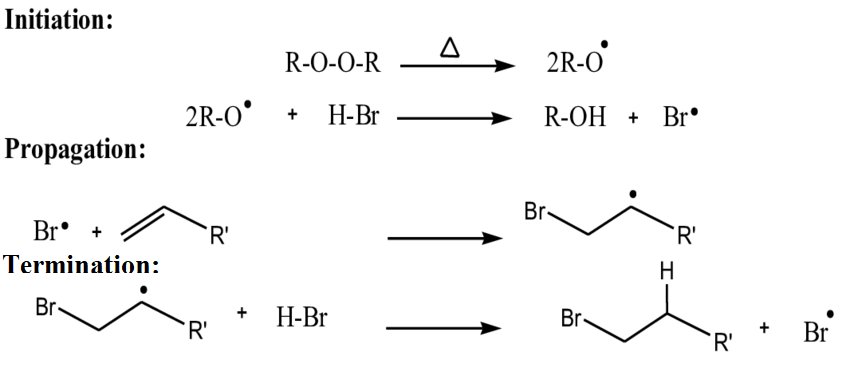
The addition of HBr to an alkene in the presence of peroxide is an example of:
A. Electrophilic addition reaction
B. Nucleophilic addition reaction
C. Free-radical addition reaction
D. Formation of carbocation as an intermediate
Answer
139.5k+ views
1 likes
Hint: When hydrogen bromide is added to alkenes in presence of peroxide, it reacts with anti-Markovnikov’s addition mechanism. Peroxides form free radicals that initiate the reaction and add bromine radical at terminal carbon.
Complete step-by-step answer:
Peroxides have a weak oxygen-oxygen bond which on heating results in homolytic fragmentation of this bond i.e. the bond breaks in order to leave one unpaired electron on each atom involved in the reaction. Strong sources of light such as floodlight or other source of light radiation which reaches into the near UV might also serve to weaken this bond.
Only a catalytic amount of peroxide is needed to get the reaction started, although one molar equivalent of HBr is essentially required to result in complete addition of HBr to the alkene.
This results in a highly reactive alkoxy radical which then abstracts hydrogen from H-Br, releasing a bromine radical. The bromine radical is the one that is added to the alkene from the molecule hydrogen bromide.
Preferably addition to an alkene tends to occur in such a way that the most stable free radical is formed, tertiary radical here in HBr. That’s the reason that bromine ends up on the least substituted carbon of the alkene. This tertiary radical then eliminates hydrogen from H-Br, liberating a bromine radical, and this way the cycle continues.

Hence, the correct option is (C).
Note: In absence of peroxide, if alkene reacts with hydrogen bromide, the attack of bromine is due to electrophilic addition reaction in which carbocation is formed as an intermediate. It is also called Markovnikov’s addition in which attack takes place on more substituted carbon.
Complete step-by-step answer:
Peroxides have a weak oxygen-oxygen bond which on heating results in homolytic fragmentation of this bond i.e. the bond breaks in order to leave one unpaired electron on each atom involved in the reaction. Strong sources of light such as floodlight or other source of light radiation which reaches into the near UV might also serve to weaken this bond.
Only a catalytic amount of peroxide is needed to get the reaction started, although one molar equivalent of HBr is essentially required to result in complete addition of HBr to the alkene.
This results in a highly reactive alkoxy radical which then abstracts hydrogen from H-Br, releasing a bromine radical. The bromine radical is the one that is added to the alkene from the molecule hydrogen bromide.
Preferably addition to an alkene tends to occur in such a way that the most stable free radical is formed, tertiary radical here in HBr. That’s the reason that bromine ends up on the least substituted carbon of the alkene. This tertiary radical then eliminates hydrogen from H-Br, liberating a bromine radical, and this way the cycle continues.

Hence, the correct option is (C).
Note: In absence of peroxide, if alkene reacts with hydrogen bromide, the attack of bromine is due to electrophilic addition reaction in which carbocation is formed as an intermediate. It is also called Markovnikov’s addition in which attack takes place on more substituted carbon.
Latest Vedantu courses for you
Grade 11 Science PCM | CBSE | SCHOOL | English
CBSE (2025-26)
School Full course for CBSE students
₹41,848 per year
EMI starts from ₹3,487.34 per month
Recently Updated Pages
Average fee range for JEE coaching in India- Complete Details

Difference Between Rows and Columns: JEE Main 2024

Difference Between Length and Height: JEE Main 2024

Difference Between Natural and Whole Numbers: JEE Main 2024

Algebraic Formula

Difference Between Constants and Variables: JEE Main 2024

Trending doubts
JEE Main 2025 Session 2: Application Form (Out), Exam Dates (Released), Eligibility, & More

JEE Main 2025: Derivation of Equation of Trajectory in Physics

JEE Main Exam Marking Scheme: Detailed Breakdown of Marks and Negative Marking

Learn About Angle Of Deviation In Prism: JEE Main Physics 2025

Number of sigma and pi bonds in C2 molecule isare A class 11 chemistry JEE_Main

Electric Field Due to Uniformly Charged Ring for JEE Main 2025 - Formula and Derivation

Other Pages
NCERT Solutions for Class 11 Chemistry Chapter 9 Hydrocarbons

NCERT Solutions for Class 11 Chemistry Chapter 7 Redox Reaction

JEE Advanced Marks vs Ranks 2025: Understanding Category-wise Qualifying Marks and Previous Year Cut-offs

NCERT Solutions for Class 11 Chemistry Chapter 5 Thermodynamics

Hydrocarbons Class 11 Notes: CBSE Chemistry Chapter 9

NCERT Solutions for Class 11 Chemistry In Hindi Chapter 1 Some Basic Concepts of Chemistry




